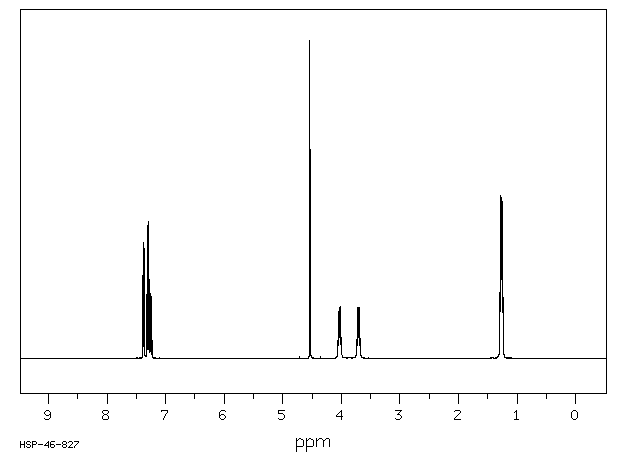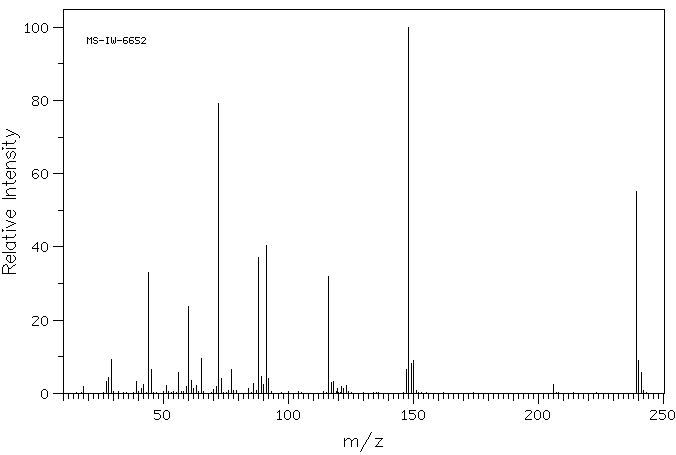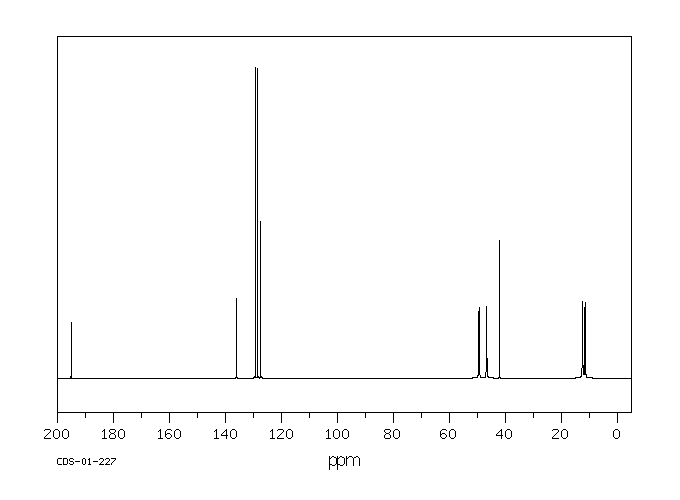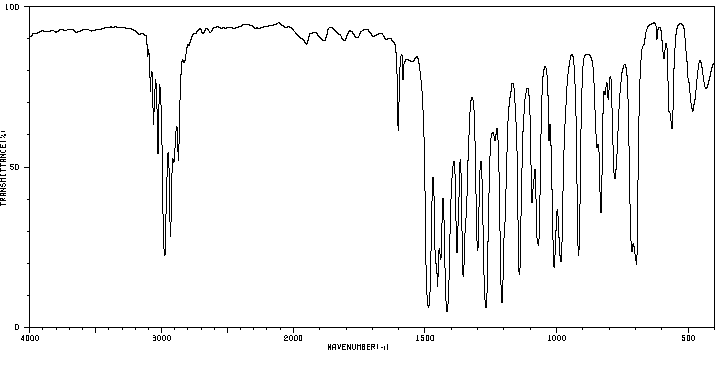二乙基二硫代氨基羧酸苄酯 | 3052-61-7
中文名称
二乙基二硫代氨基羧酸苄酯
中文别名
——
英文名称
benzyl diethylcarbamodithioate
英文别名
benzyl N,N-diethyldithiocarbamate;Benzyl diethyldithiocarbamate;benzyl N,N-diethylcarbamodithioate
CAS
3052-61-7
化学式
C12H17NS2
mdl
MFCD00191425
分子量
239.406
InChiKey
SNBMGLUIIGFNFE-UHFFFAOYSA-N
BEILSTEIN
——
EINECS
——
-
物化性质
-
计算性质
-
ADMET
-
安全信息
-
SDS
-
制备方法与用途
-
上下游信息
-
文献信息
-
表征谱图
-
同类化合物
-
相关功能分类
-
相关结构分类
物化性质
-
沸点:172 °C / 15mmHg
-
密度:1.12
-
稳定性/保质期:
遵照规定使用和储存,则不会分解。
计算性质
-
辛醇/水分配系数(LogP):3.5
-
重原子数:15
-
可旋转键数:5
-
环数:1.0
-
sp3杂化的碳原子比例:0.416
-
拓扑面积:60.6
-
氢给体数:0
-
氢受体数:2
安全信息
-
海关编码:2930909090
-
危险性防范说明:P264,P280,P302+P352,P332+P313,P362,P305+P351+P338,P337+P313
-
危险性描述:H315,H319
-
储存条件:存放于阴凉干燥处。
SDS
二乙基二硫代氨基羧酸苄酯 修改号码:2
模块 1. 化学品
产品名称: Benzyl Diethyldithiocarbamate
修改号码: 2
模块 2. 危险性概述
GHS分类
物理性危害 未分类
健康危害
皮肤腐蚀/刺激 第2级
严重损伤/刺激眼睛 2A类
环境危害 未分类
GHS标签元素
图标或危害标志
信号词 警告
危险描述 造成皮肤刺激
造成严重眼刺激
防范说明
[预防] 处理后要彻底清洗双手。
穿戴防护手套/护目镜/防护面具。
[急救措施] 眼睛接触:用水小心清洗几分钟。如果方便,易操作,摘除隐形眼镜。继续冲洗。
眼睛接触:求医/就诊
皮肤接触:用大量肥皂和水轻轻洗。
若皮肤刺激:求医/就诊。
脱掉被污染的衣物,清洗后方可重新使用。
模块 3. 成分/组成信息
单一物质/混和物 单一物质
化学名(中文名): 二乙基二硫代氨基羧酸苄酯
百分比: >98.0%(GC)
CAS编码: 3052-61-7
俗名: Diethyldithiocarbamic Acid Benzyl Ester
分子式: C12H17NS2
二乙基二硫代氨基羧酸苄酯 修改号码:2
模块 4. 急救措施
吸入: 将受害者移到新鲜空气处,保持呼吸通畅,休息。若感不适请求医/就诊。
皮肤接触: 立即去除/脱掉所有被污染的衣物。用大量肥皂和水轻轻洗。
若皮肤刺激或发生皮疹:求医/就诊。
眼睛接触: 用水小心清洗几分钟。如果方便,易操作,摘除隐形眼镜。继续清洗。
如果眼睛刺激:求医/就诊。
食入: 若感不适,求医/就诊。漱口。
紧急救助者的防护: 救援者需要穿戴个人防护用品,比如橡胶手套和气密性护目镜。
模块 5. 消防措施
合适的灭火剂: 干粉,泡沫,雾状水,二氧化碳
不适用的灭火剂: 棒状水
特殊危险性: 小心,燃烧或高温下可能分解产生毒烟。
特定方法: 从上风处灭火,根据周围环境选择合适的灭火方法。
非相关人员应该撤离至安全地方。
周围一旦着火:如果安全,移去可移动容器。
消防员的特殊防护用具: 灭火时,一定要穿戴个人防护用品。
模块 6. 泄漏应急处理
个人防护措施,防护用具, 使用个人防护用品。远离溢出物/泄露处并处在上风处。确保足够通风。
紧急措施: 泄露区应该用安全带等圈起来,控制非相关人员进入。
环保措施: 防止进入下水道。
控制和清洗的方法和材料: 用合适的吸收剂(如:旧布,干砂,土,锯屑)吸收泄漏物。一旦大量泄漏,筑堤控
制。附着物或收集物应该立即根据合适的法律法规废弃处置。
模块 7. 操作处置与储存
处理
技术措施: 在通风良好处进行处理。穿戴合适的防护用具。防止烟雾产生。处理后彻底清洗双手
和脸。
注意事项: 如果蒸气或浮质产生,使用通风、局部排气。
操作处置注意事项: 避免接触皮肤、眼睛和衣物。
贮存
储存条件: 保持容器密闭。存放于凉爽、阴暗处。
远离不相容的材料比如氧化剂存放。
包装材料: 依据法律。
模块 8. 接触控制和个体防护
工程控制: 尽可能安装封闭体系或局部排风系统,操作人员切勿直接接触。同时安装淋浴器和洗
眼器。
个人防护用品
呼吸系统防护: 防毒面具。依据当地和政府法规。
手部防护: 防护手套。
眼睛防护: 安全防护镜。如果情况需要,佩戴面具。
皮肤和身体防护: 防护服。如果情况需要,穿戴防护靴。
模块 9. 理化特性
液体
外形(20°C):
外观: 透明
颜色: 黄色-黄红色
二乙基二硫代氨基羧酸苄酯 修改号码:2
模块 9. 理化特性
气味: 无资料
pH: 无数据资料
熔点: 无资料
沸点/沸程 172 °C/2kPa
闪点: 无资料
爆炸特性
爆炸下限: 无资料
爆炸上限: 无资料
密度: 1.12
溶解度: 无资料
模块 10. 稳定性和反应性
稳定性: 一般情况下稳定。
反应性: 未报道特殊反应性。
须避免接触的物质 氧化剂
危险的分解产物: 一氧化碳, 二氧化碳, 氮氧化物 (NOx), 硫氧化物
模块 11. 毒理学信息
急性毒性: 无资料
对皮肤腐蚀或刺激: 无资料
对眼睛严重损害或刺激: 无资料
生殖细胞变异原性: 无资料
致癌性:
IARC = 无资料
NTP = 无资料
生殖毒性: 无资料
模块 12. 生态学信息
生态毒性:
鱼类: 无资料
甲壳类: 无资料
藻类: 无资料
残留性 / 降解性: 无资料
潜在生物累积 (BCF): 无资料
土壤中移动性
log水分配系数: 无资料
土壤吸收系数 (Koc): 无资料
亨利定律 无资料
constaNT(PaM3/mol):
模块 13. 废弃处置
如果可能,回收处理。请咨询当地管理部门。建议在装有后燃和洗涤装置的化学焚烧炉中焚烧。废弃处置时请遵守
国家、地区和当地的所有法规。
模块 14. 运输信息
联合国分类: 与联合国分类标准不一致
UN编号: 未列明
二乙基二硫代氨基羧酸苄酯 修改号码:2
模块 15. 法规信息
《危险化学品安全管理条例》(2002年1月26日国务院发布): 针对危险化学品的安全使用、生产、储存、运输、装
卸等方面均作了相应的规定。
模块16 - 其他信息
N/A
模块 1. 化学品
产品名称: Benzyl Diethyldithiocarbamate
修改号码: 2
模块 2. 危险性概述
GHS分类
物理性危害 未分类
健康危害
皮肤腐蚀/刺激 第2级
严重损伤/刺激眼睛 2A类
环境危害 未分类
GHS标签元素
图标或危害标志
信号词 警告
危险描述 造成皮肤刺激
造成严重眼刺激
防范说明
[预防] 处理后要彻底清洗双手。
穿戴防护手套/护目镜/防护面具。
[急救措施] 眼睛接触:用水小心清洗几分钟。如果方便,易操作,摘除隐形眼镜。继续冲洗。
眼睛接触:求医/就诊
皮肤接触:用大量肥皂和水轻轻洗。
若皮肤刺激:求医/就诊。
脱掉被污染的衣物,清洗后方可重新使用。
模块 3. 成分/组成信息
单一物质/混和物 单一物质
化学名(中文名): 二乙基二硫代氨基羧酸苄酯
百分比: >98.0%(GC)
CAS编码: 3052-61-7
俗名: Diethyldithiocarbamic Acid Benzyl Ester
分子式: C12H17NS2
二乙基二硫代氨基羧酸苄酯 修改号码:2
模块 4. 急救措施
吸入: 将受害者移到新鲜空气处,保持呼吸通畅,休息。若感不适请求医/就诊。
皮肤接触: 立即去除/脱掉所有被污染的衣物。用大量肥皂和水轻轻洗。
若皮肤刺激或发生皮疹:求医/就诊。
眼睛接触: 用水小心清洗几分钟。如果方便,易操作,摘除隐形眼镜。继续清洗。
如果眼睛刺激:求医/就诊。
食入: 若感不适,求医/就诊。漱口。
紧急救助者的防护: 救援者需要穿戴个人防护用品,比如橡胶手套和气密性护目镜。
模块 5. 消防措施
合适的灭火剂: 干粉,泡沫,雾状水,二氧化碳
不适用的灭火剂: 棒状水
特殊危险性: 小心,燃烧或高温下可能分解产生毒烟。
特定方法: 从上风处灭火,根据周围环境选择合适的灭火方法。
非相关人员应该撤离至安全地方。
周围一旦着火:如果安全,移去可移动容器。
消防员的特殊防护用具: 灭火时,一定要穿戴个人防护用品。
模块 6. 泄漏应急处理
个人防护措施,防护用具, 使用个人防护用品。远离溢出物/泄露处并处在上风处。确保足够通风。
紧急措施: 泄露区应该用安全带等圈起来,控制非相关人员进入。
环保措施: 防止进入下水道。
控制和清洗的方法和材料: 用合适的吸收剂(如:旧布,干砂,土,锯屑)吸收泄漏物。一旦大量泄漏,筑堤控
制。附着物或收集物应该立即根据合适的法律法规废弃处置。
模块 7. 操作处置与储存
处理
技术措施: 在通风良好处进行处理。穿戴合适的防护用具。防止烟雾产生。处理后彻底清洗双手
和脸。
注意事项: 如果蒸气或浮质产生,使用通风、局部排气。
操作处置注意事项: 避免接触皮肤、眼睛和衣物。
贮存
储存条件: 保持容器密闭。存放于凉爽、阴暗处。
远离不相容的材料比如氧化剂存放。
包装材料: 依据法律。
模块 8. 接触控制和个体防护
工程控制: 尽可能安装封闭体系或局部排风系统,操作人员切勿直接接触。同时安装淋浴器和洗
眼器。
个人防护用品
呼吸系统防护: 防毒面具。依据当地和政府法规。
手部防护: 防护手套。
眼睛防护: 安全防护镜。如果情况需要,佩戴面具。
皮肤和身体防护: 防护服。如果情况需要,穿戴防护靴。
模块 9. 理化特性
液体
外形(20°C):
外观: 透明
颜色: 黄色-黄红色
二乙基二硫代氨基羧酸苄酯 修改号码:2
模块 9. 理化特性
气味: 无资料
pH: 无数据资料
熔点: 无资料
沸点/沸程 172 °C/2kPa
闪点: 无资料
爆炸特性
爆炸下限: 无资料
爆炸上限: 无资料
密度: 1.12
溶解度: 无资料
模块 10. 稳定性和反应性
稳定性: 一般情况下稳定。
反应性: 未报道特殊反应性。
须避免接触的物质 氧化剂
危险的分解产物: 一氧化碳, 二氧化碳, 氮氧化物 (NOx), 硫氧化物
模块 11. 毒理学信息
急性毒性: 无资料
对皮肤腐蚀或刺激: 无资料
对眼睛严重损害或刺激: 无资料
生殖细胞变异原性: 无资料
致癌性:
IARC = 无资料
NTP = 无资料
生殖毒性: 无资料
模块 12. 生态学信息
生态毒性:
鱼类: 无资料
甲壳类: 无资料
藻类: 无资料
残留性 / 降解性: 无资料
潜在生物累积 (BCF): 无资料
土壤中移动性
log水分配系数: 无资料
土壤吸收系数 (Koc): 无资料
亨利定律 无资料
constaNT(PaM3/mol):
模块 13. 废弃处置
如果可能,回收处理。请咨询当地管理部门。建议在装有后燃和洗涤装置的化学焚烧炉中焚烧。废弃处置时请遵守
国家、地区和当地的所有法规。
模块 14. 运输信息
联合国分类: 与联合国分类标准不一致
UN编号: 未列明
二乙基二硫代氨基羧酸苄酯 修改号码:2
模块 15. 法规信息
《危险化学品安全管理条例》(2002年1月26日国务院发布): 针对危险化学品的安全使用、生产、储存、运输、装
卸等方面均作了相应的规定。
模块16 - 其他信息
N/A
上下游信息
-
上游原料
中文名称 英文名称 CAS号 化学式 分子量 —— S-benzyl N-ethyldithiocarbamate 28249-01-6 C10H13NS2 211.352 -
下游产品
中文名称 英文名称 CAS号 化学式 分子量 二乙基硫代氨基甲酸 S-苄酯 S-Benzyl N,N-diethylthiocarbamate 30085-50-8 C12H17NOS 223.339
反应信息
-
作为反应物:描述:二乙基二硫代氨基羧酸苄酯 在 碳酸氢钠 、 间氯过氧苯甲酸 作用下, 以 二氯甲烷 为溶剂, 反应 4.0h, 以45%的产率得到N-[benzylsulfanyl(sulfinyl)methyl]-N-ethylethanamine参考文献:名称:二硫代氨基甲酸酯的氧化和稳定亚砜的合成摘要:对各种二硫代氨基甲酸酯的氧化反应的研究表明,形成了相应的亚砜(S-氧化物)。尽管它们的稳定性非常适中,但仍可以分离和表征许多亚砜。当置于环境温度下时,它们分解为硫代氨基甲酸酯和二硫代氨基甲酸酯。来自仲二硫代氨基甲酸酯的亚砜导致形成二硫化物,对此进行了解释。通过在硫原子上存在空间位阻的芳基,制备了稳定的硫,并对其晶体结构进行了分析。DOI:10.1016/s0040-4039(98)02033-4
-
作为产物:描述:溴甲苯 以59%的产率得到参考文献:名称:VILLEMIN, DIDIER;THIBAULT, FREDERIC;LE, MINOR ANNE, CHEM. AND IND.,(1989) N0, C. 687-688摘要:DOI:
文献信息
-
Electrogenerated Base-Promoted Synthesis of Dithiocarbamate Acid Esters and 3-(<i>N</i>-Substituted-amino)-2-cyanodithiocrotonates from Primary or Secondary Amines and Carbon Disulfide作者:Meriem Toumi、Noureddine Raouafi、Khaled Boujlel、Issa Tapsoba、Jean-Paul Picard、Michel BordeauDOI:10.1080/10426500701501607日期:2008.9.5Electrogenerated cyanomethyl anion promotes the reaction between primary or secondary amines, carbon disulfide, and alkyl or benzyl halide. Secondary amines are converted to alkyl or benzyl dithiocarbamates, whereas primary amines give N-substituted alkyl or benzyl 3-amino-2-cyanodithiocrotonates. The mechanisms are discussed.
-
Thiocarbonylthio Compounds (SC(Z)S−R) in Free Radical Polymerization with Reversible Addition-Fragmentation Chain Transfer (RAFT Polymerization). Effect of the Activating Group Z作者:John Chiefari、Roshan T. A. Mayadunne、Catherine L. Moad、Graeme Moad、Ezio Rizzardo、Almar Postma、Melissa A. Skidmore, and、San H. ThangDOI:10.1021/ma020883+日期:2003.4.1Free-radical polymerization in the presence of suitable addition−fragmentation chain transfer agents [SC(Z)S−R] (RAFT agents) possess the characteristics of a living polymerization (i.e., polymer products can be reactivated for chain extension and/or block synthesis, molecular weights are predetermined by RAFT agent concentration and conversion, narrow polydispersities are possible). Styrene polymerizations在合适的加成-断裂链转移剂[SC (Z)S-R](RAFT剂)存在下的自由基聚合具有活性聚合的特征(即,可以将聚合物产物重新活化以进行链增长和/或嵌段合成,分子量由RAFT剂的浓度和转化率预先确定,可能会有较窄的多分散性。对两个系列的RAFT试剂[S C(Z)S-CH 2 Ph和S C(Z)S-C(Me)2 CN]进行苯乙烯聚合(110℃,热引发)。链转移系数降低在串联其中Z为Ph> SCH 2 pH约SMe的〜我〜ñ -吡咯»OC 6 ˚F 5 > Ñ-内酰胺> OC 6 H 5 > O(烷基)≫ N(烷基)2(仅该系列的前五个在间歇聚合中提供窄的多分散性聚苯乙烯(<1.2))。更一般地,在二硫代苯甲酸酯>三硫代碳酸酯-二硫代链烷酸酯>二硫代碳酸酯(黄原酸酯)>二硫代氨基甲酸酯系列中,链转移系数降低。然而,Z上的吸电子取代基可以增强RAFT剂改变上述顺序的活性。因此,使氧或氮孤对更不可用
-
An Efficient Synthesis of Benzyl Dithiocarbamates by Base-Promoted Cross-Coupling Reactions of Benzyl Chlorides with Tetraalkylthiuram Disulfides at Room Temperature作者:Zhiyong Wu、Miao Lai、Siyuan Zhang、Xianyun Zhong、Hao Song、Mingqin ZhaoDOI:10.1002/ejoc.201801449日期:2018.12.31A mild and efficient synthesis of benzyl dithiocarbamates through transition metal free cross‐coupling reactions was developed. This attractive methodology for the synthesis of benzyl dithiocarbamate derivatives is of great significance due to the potential utilization of the product in pharmaceutical industry.
-
Transition-Metal-Free C(sp<sup>3</sup> )-S Coupling in Water: Synthesis of Benzyl Dithiocarbamates Using Thiuram Disulfides as an Organosulfur Source作者:Han-Ying Peng、Zhi-Bing DongDOI:10.1002/ejoc.201801520日期:2019.2.7TBTD), the desired C(sp3)‐S coupling products (benzyl dithiocarbamates) could be obtained in good to excellent yields. The protocol features advantages of experimental simplicity, water as solvent, metal‐free, good functional compatibility, good to excellent yields, illustrating its potential synthetic value in the convenient preparation of some potentially biologically active compounds.
-
An efficient synthesis of dithiocarbamates under ultrasound irradiation in water作者:Najmadin Azizi、Elahm Gholibeglo、Sanaz Dehghan NayeriDOI:10.1007/s00706-011-0687-z日期:2012.8economic, and green method for the synthesis of dithiocarbamate derivatives in water. The one-pot, three-component condensation of primary and secondary amines with carbon disulfide and unsaturated carbonyl compounds or alkyl halides under ultrasonic irradiation was developed as a green and fast protocol for the rapid high-yielding preparation of dithiocarbamates in water. Graphical abstract
表征谱图
-
氢谱1HNMR
-
质谱MS
-
碳谱13CNMR
-
红外IR
-
拉曼Raman
-
峰位数据
-
峰位匹配
-
表征信息
同类化合物
(βS)-β-氨基-4-(4-羟基苯氧基)-3,5-二碘苯甲丙醇
(S,S)-邻甲苯基-DIPAMP
(S)-(-)-7'-〔4(S)-(苄基)恶唑-2-基]-7-二(3,5-二-叔丁基苯基)膦基-2,2',3,3'-四氢-1,1-螺二氢茚
(S)-盐酸沙丁胺醇
(S)-3-(叔丁基)-4-(2,6-二甲氧基苯基)-2,3-二氢苯并[d][1,3]氧磷杂环戊二烯
(S)-2,2'-双[双(3,5-三氟甲基苯基)膦基]-4,4',6,6'-四甲氧基联苯
(S)-1-[3,5-双(三氟甲基)苯基]-3-[1-(二甲基氨基)-3-甲基丁烷-2-基]硫脲
(R)富马酸托特罗定
(R)-(-)-盐酸尼古地平
(R)-(-)-4,12-双(二苯基膦基)[2.2]对环芳烷(1,5环辛二烯)铑(I)四氟硼酸盐
(R)-(+)-7-双(3,5-二叔丁基苯基)膦基7''-[((6-甲基吡啶-2-基甲基)氨基]-2,2'',3,3''-四氢-1,1''-螺双茚满
(R)-(+)-7-双(3,5-二叔丁基苯基)膦基7''-[(4-叔丁基吡啶-2-基甲基)氨基]-2,2'',3,3''-四氢-1,1''-螺双茚满
(R)-(+)-7-双(3,5-二叔丁基苯基)膦基7''-[(3-甲基吡啶-2-基甲基)氨基]-2,2'',3,3''-四氢-1,1''-螺双茚满
(R)-(+)-4,7-双(3,5-二-叔丁基苯基)膦基-7“-[(吡啶-2-基甲基)氨基]-2,2”,3,3'-四氢1,1'-螺二茚满
(R)-3-(叔丁基)-4-(2,6-二苯氧基苯基)-2,3-二氢苯并[d][1,3]氧杂磷杂环戊烯
(R)-2-[((二苯基膦基)甲基]吡咯烷
(R)-1-[3,5-双(三氟甲基)苯基]-3-[1-(二甲基氨基)-3-甲基丁烷-2-基]硫脲
(N-(4-甲氧基苯基)-N-甲基-3-(1-哌啶基)丙-2-烯酰胺)
(5-溴-2-羟基苯基)-4-氯苯甲酮
(5-溴-2-氯苯基)(4-羟基苯基)甲酮
(5-氧代-3-苯基-2,5-二氢-1,2,3,4-oxatriazol-3-鎓)
(4S,5R)-4-甲基-5-苯基-1,2,3-氧代噻唑烷-2,2-二氧化物-3-羧酸叔丁酯
(4S,4''S)-2,2''-亚环戊基双[4,5-二氢-4-(苯甲基)恶唑]
(4-溴苯基)-[2-氟-4-[6-[甲基(丙-2-烯基)氨基]己氧基]苯基]甲酮
(4-丁氧基苯甲基)三苯基溴化磷
(3aR,8aR)-(-)-4,4,8,8-四(3,5-二甲基苯基)四氢-2,2-二甲基-6-苯基-1,3-二氧戊环[4,5-e]二恶唑磷
(3aR,6aS)-5-氧代六氢环戊基[c]吡咯-2(1H)-羧酸酯
(2Z)-3-[[(4-氯苯基)氨基]-2-氰基丙烯酸乙酯
(2S,3S,5S)-5-(叔丁氧基甲酰氨基)-2-(N-5-噻唑基-甲氧羰基)氨基-1,6-二苯基-3-羟基己烷
(2S,2''S,3S,3''S)-3,3''-二叔丁基-4,4''-双(2,6-二甲氧基苯基)-2,2'',3,3''-四氢-2,2''-联苯并[d][1,3]氧杂磷杂戊环
(2S)-(-)-2-{[[[[3,5-双(氟代甲基)苯基]氨基]硫代甲基]氨基}-N-(二苯基甲基)-N,3,3-三甲基丁酰胺
(2S)-2-[[[[[((1S,2S)-2-氨基环己基]氨基]硫代甲基]氨基]-N-(二苯甲基)-N,3,3-三甲基丁酰胺
(2S)-2-[[[[[[((1R,2R)-2-氨基环己基]氨基]硫代甲基]氨基]-N-(二苯甲基)-N,3,3-三甲基丁酰胺
(2-硝基苯基)磷酸三酰胺
(2,6-二氯苯基)乙酰氯
(2,3-二甲氧基-5-甲基苯基)硼酸
(1S,2S,3S,5S)-5-叠氮基-3-(苯基甲氧基)-2-[(苯基甲氧基)甲基]环戊醇
(1S,2S,3R,5R)-2-(苄氧基)甲基-6-氧杂双环[3.1.0]己-3-醇
(1-(4-氟苯基)环丙基)甲胺盐酸盐
(1-(3-溴苯基)环丁基)甲胺盐酸盐
(1-(2-氯苯基)环丁基)甲胺盐酸盐
(1-(2-氟苯基)环丙基)甲胺盐酸盐
(1-(2,6-二氟苯基)环丙基)甲胺盐酸盐
(-)-去甲基西布曲明
龙蒿油
龙胆酸钠
龙胆酸叔丁酯
龙胆酸
龙胆紫-d6
龙胆紫










